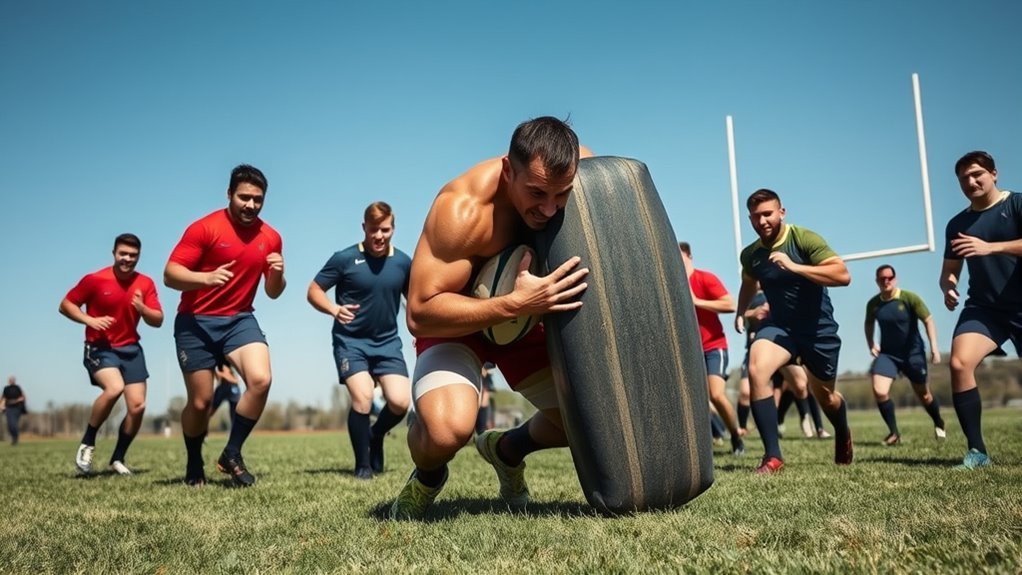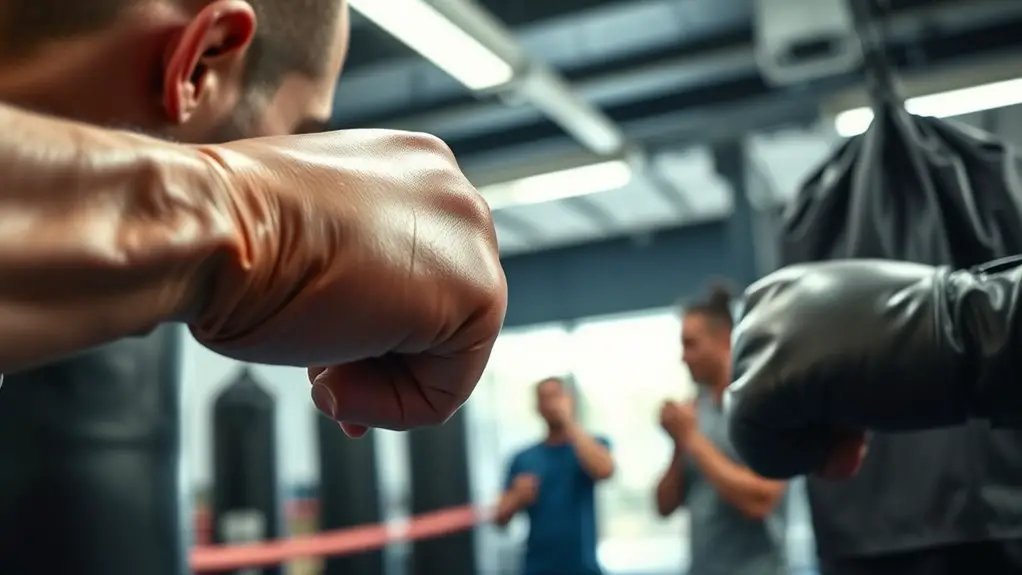To improve your tackling strength in rugby, focus on mastering key techniques like proper body positioning and head placement. Incorporate essential strength training exercises such as squats and deadlifts to build overall strength. Don't forget about explosive plyometrics like box jumps to enhance power and agility. Finally, prioritize recovery strategies like stretching and hydration to prevent injuries. By refining these areas, you'll boost your tackling performance and find out even more strategies to excel on the field.
Understanding the Importance of Tackling Strength
When you step onto the rugby field, understanding the importance of tackling strength can make all the difference in your performance. Tackling isn't just about brute force; it's about control, timing, and technique. Strong tackles can disrupt opponents' plays, giving your team an edge. Imagine the freedom you feel when you confidently bring down an opponent, knowing your strength supports your teammates. It's not just a physical advantage, but a mental boost as well. The more you build your tackling strength, the more fearless you'll become during games. You'll take charge of the field, knowing you can withstand and deliver impactful tackles. Embracing this aspect of the game allows you to express your true potential and passion for rugby.
Key Techniques for Effective Tackling
Mastering key techniques for effective tackling can elevate your game and enhance your confidence on the field. Here are three essential techniques to focus on:
Mastering key tackling techniques can boost your performance and confidence on the field.
- Body Positioning: Keep your knees bent and your weight low. This stance gives you stability and readiness to engage.
- Head Placement: Always position your head to the side of the opponent's body. This not only protects your neck but also allows for a more secure grip during the tackle.
- Follow Through: After making contact, drive your legs and follow through with the tackle. This guarantees you bring your opponent down effectively and maintains your momentum.
Essential Strength Training Exercises
Building tackling strength is essential for rugby players looking to enhance their performance on the field. To achieve this, focus on key strength training exercises that target your core, legs, and upper body. Here are some essential exercises you should incorporate into your routine:
| Exercise | Benefits |
|---|---|
| Squats | Builds leg strength |
| Deadlifts | Strengthens the posterior chain |
| Bench Press | Develops upper body power |
| Rows | Enhances back strength |
These exercises will not only improve your tackling ability but also boost your overall athletic performance. Make sure you maintain proper form and gradually increase the weights to maximize your gains. Embrace the freedom of movement and strength these exercises provide!
Incorporating Plyometrics for Explosive Power
Incorporating plyometrics into your training regimen can considerably boost your explosive power on the rugby field. These dynamic movements help you harness your strength for quicker, more effective tackles. Here are three plyometric exercises you should consider adding:
- Box Jumps: Jump onto a sturdy box or platform, focusing on landing softly to reduce impact. This builds leg strength and explosiveness.
- Depth Jumps: Step off a box, then leap immediately upon landing. This trains your muscles to react quickly and build power.
- Broad Jumps: Jump forward as far as possible, using your arms for momentum. It enhances your overall explosive strength and agility.
Embrace these exercises, and you'll feel the difference in your tackling abilities on the field!
Drills to Practice Tackling Form and Technique
While you may have the strength to make a tackle, perfecting your form and technique is essential for both effectiveness and safety. Start with the "Hawk Tackle Drill," where you focus on keeping your head up and wrapping your arms around a tackling pad. This promotes proper body positioning. Next, try the "Shadow Tackle," where you practice your movements without a partner, guaranteeing your footwork is on point. Incorporate "One-on-One Tackles" with a teammate, emphasizing low body position and the drive through the hips. Finally, the "Tackle Bag Drill" allows you to reinforce your technique against a stationary target. These drills not only build confidence but also guarantee you're tackling smartly, reducing injury risk while maximizing your impact on the field.
Enhancing Core Stability for Better Tackling
To tackle effectively, you need a strong core, as it plays an essential role in maintaining balance and stability during contact. A stable core helps you absorb impact and deliver powerful tackles. Here are three ways to enhance your core stability:
A strong core is vital for effective tackling, ensuring balance and stability during contact.
- Plank Variations: Incorporate side planks and shoulder taps to challenge your stability while building endurance.
- Medicine Ball Throws: Use a medicine ball for rotational throws to engage your core dynamically, simulating the twisting motion during tackles.
- Single-Leg Exercises: Perform single-leg squats or deadlifts to improve balance and strengthen stabilizing muscles.
Recovery and Injury Prevention Strategies
Building a strong core is only one piece of the puzzle when it comes to effective tackling in rugby. Recovery and injury prevention are just as essential for maintaining your performance. Make sure you prioritize rest days; your body needs time to heal and rebuild. Incorporate stretching and foam rolling into your routine to keep your muscles flexible and reduce soreness. Don't underestimate the power of hydration and nutrition—fueling your body properly can make a significant difference in recovery. Additionally, consider cross-training to strengthen different muscle groups, which helps prevent overuse injuries. Always listen to your body; if something feels off, take a step back. Embrace these strategies, and you'll keep tackling strong while enjoying the freedom of the game.
Frequently Asked Questions
How Does Tackling Strength Impact Overall Rugby Performance?
Tackling strength's essential for your rugby performance; it enhances your ability to stop opponents effectively. When you're strong in tackles, you gain confidence, improve defensive skills, and help your team maintain possession, ultimately leading to success.
What Is the Best Age to Start Strength Training for Tackling?
Starting strength training at around 14, when your body's like a sprouting tree, can help you develop a solid foundation. You'll gain confidence, agility, and power, paving the way for a successful rugby journey ahead.
Can Nutrition Influence Tackling Strength Development?
Absolutely, your nutrition plays an essential role in developing strength. By fueling your body with the right nutrients, you'll enhance recovery, build muscle, and ultimately improve your tackling power on the field. Prioritize a balanced diet!
How Often Should I Train Tackling Strength Weekly?
You should train tackling strength about three to four times a week—like a lion sharpening its claws! Balance your sessions with rest days. You'll find your body and skills thriving in ways you never dreamed.
What Role Does Mental Preparation Play in Tackling Strength?
Mental preparation's essential for your tackling strength. It boosts confidence, sharpens focus, and helps you anticipate opponents' moves. By visualizing success, you'll feel more empowered and ready to tackle challenges both on and off the field.




